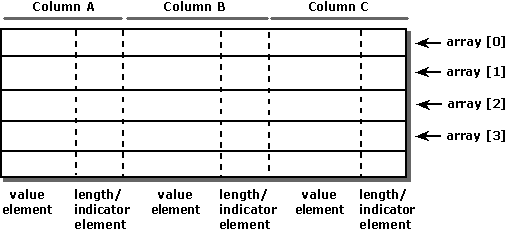Associazione per riga
Quando si usa l’associazione a livello di riga, un'applicazione definisce una struttura contenente uno o due elementi, o in alcuni casi tre, per ogni colonna per cui devono essere restituiti i dati. Il primo elemento contiene il valore dei dati e il secondo elemento contiene il buffer di lunghezza/indicatore. Gli indicatori e i valori di lunghezza possono essere archiviati in buffer separati impostando i campi descrittore SQL_DESC_INDICATOR_PTR e SQL_DESC_OCTET_LENGTH_PTR su valori diversi; se questa operazione viene eseguita, la struttura contiene un terzo elemento. L'applicazione alloca quindi una matrice di queste strutture, che contiene tanti elementi quante sono le righe nel set di righe.
L'applicazione dichiara le dimensioni della struttura al driver con l'attributo di istruzione SQL_ATTR_ROW_BIND_TYPE e associa l'indirizzo di ogni membro nel primo elemento della matrice. Pertanto, il driver può calcolare l'indirizzo dei dati per una determinata riga e colonna
Address = Bound Address + ((Row Number - 1) * Structure Size)
dove le righe sono numerate da 1 alla dimensione del set di righe. (Uno viene sottratto dal numero di riga perché l'indicizzazione della matrice in C è in base zero.) Nella figura seguente viene illustrato il funzionamento dell'associazione a livello di riga. In genere, nella struttura sono incluse solo le colonne che verranno associate. La struttura può contenere campi non correlati alle colonne del set di risultati. Le colonne possono essere inserite nella struttura in qualsiasi ordine, ma vengono visualizzate in ordine sequenziale per maggiore chiarezza.

Il codice seguente, ad esempio, crea una struttura con elementi in cui restituire i dati per le colonne OrderID, SalesPerson e Status e lunghezza/indicatori per le colonne SalesPerson e Status. Alloca 10 di queste strutture e le associa alle colonne OrderID, SalesPerson e Status.
#define ROW_ARRAY_SIZE 10
// Define the ORDERINFO struct and allocate an array of 10 structs.
typedef struct {
SQLUINTEGER OrderID;
SQLINTEGER OrderIDInd;
SQLCHAR SalesPerson[11];
SQLINTEGER SalesPersonLenOrInd;
SQLCHAR Status[7];
SQLINTEGER StatusLenOrInd;
} ORDERINFO;
ORDERINFO OrderInfoArray[ROW_ARRAY_SIZE];
SQLULEN NumRowsFetched;
SQLUSMALLINT RowStatusArray[ROW_ARRAY_SIZE], i;
SQLRETURN rc;
SQLHSTMT hstmt;
// Specify the size of the structure with the SQL_ATTR_ROW_BIND_TYPE
// statement attribute. This also declares that row-wise binding will
// be used. Declare the rowset size with the SQL_ATTR_ROW_ARRAY_SIZE
// statement attribute. Set the SQL_ATTR_ROW_STATUS_PTR statement
// attribute to point to the row status array. Set the
// SQL_ATTR_ROWS_FETCHED_PTR statement attribute to point to
// NumRowsFetched.
SQLSetStmtAttr(hstmt, SQL_ATTR_ROW_BIND_TYPE, sizeof(ORDERINFO), 0);
SQLSetStmtAttr(hstmt, SQL_ATTR_ROW_ARRAY_SIZE, ROW_ARRAY_SIZE, 0);
SQLSetStmtAttr(hstmt, SQL_ATTR_ROW_STATUS_PTR, RowStatusArray, 0);
SQLSetStmtAttr(hstmt, SQL_ATTR_ROWS_FETCHED_PTR, &NumRowsFetched, 0);
// Bind elements of the first structure in the array to the OrderID,
// SalesPerson, and Status columns.
SQLBindCol(hstmt, 1, SQL_C_ULONG, &OrderInfoArray[0].OrderID, 0, &OrderInfoArray[0].OrderIDInd);
SQLBindCol(hstmt, 2, SQL_C_CHAR, OrderInfoArray[0].SalesPerson,
sizeof(OrderInfoArray[0].SalesPerson),
&OrderInfoArray[0].SalesPersonLenOrInd);
SQLBindCol(hstmt, 3, SQL_C_CHAR, OrderInfoArray[0].Status,
sizeof(OrderInfoArray[0].Status), &OrderInfoArray[0].StatusLenOrInd);
// Execute a statement to retrieve rows from the Orders table.
SQLExecDirect(hstmt, "SELECT OrderID, SalesPerson, Status FROM Orders", SQL_NTS);
// Fetch up to the rowset size number of rows at a time. Print the actual
// number of rows fetched; this number is returned in NumRowsFetched.
// Check the row status array to print only those rows successfully
// fetched. Code to check if rc equals SQL_SUCCESS_WITH_INFO or
// SQL_ERRORnot shown.
while ((rc = SQLFetchScroll(hstmt,SQL_FETCH_NEXT,0)) != SQL_NO_DATA) {
for (i = 0; i < NumRowsFetched; i++) {
if (RowStatusArray[i] == SQL_ROW_SUCCESS|| RowStatusArray[i] ==
SQL_ROW_SUCCESS_WITH_INFO) {
if (OrderInfoArray[i].OrderIDInd == SQL_NULL_DATA)
printf(" NULL ");
else
printf("%d\t", OrderInfoArray[i].OrderID);
if (OrderInfoArray[i].SalesPersonLenOrInd == SQL_NULL_DATA)
printf(" NULL ");
else
printf("%s\t", OrderInfoArray[i].SalesPerson);
if (OrderInfoArray[i].StatusLenOrInd == SQL_NULL_DATA)
printf(" NULL\n");
else
printf("%s\n", OrderInfoArray[i].Status);
}
}
}
// Close the cursor.
SQLCloseCursor(hstmt);